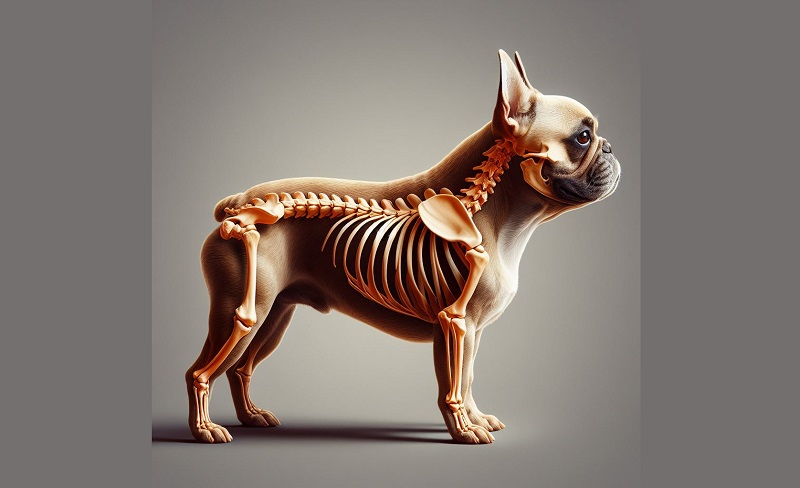IVDD in French Bulldogs
Intervertebral Disc Disease (IVDD) represents a significant health concern for French Bulldogs, given their predisposition to spine-related issues.

Written By
Dan Harrison
Editor

Co-Written By
David Anderson
Writer

Reviewed By
Penny Worthington
Health

Research By
Sammi Slater
Researcher
Page Last Updated: 10th May 2024
On this page
Quickly find and read what interests you the most using the links below:
What is IVDD?
Intervertebral Disc Disease (IVDD) involves the degeneration and failure of the intervertebral discs, which act as cushions between the spine’s vertebrae.
These discs allow the spine to be flexible and absorb shock during movement.
When these discs deteriorate or are damaged, they can compress spinal cord nerves, causing pain, mobility issues, and, in severe cases, paralysis.
Type I IVDD
Characteristics
Type I IVDD is marked by the sudden herniation of the disc material into the spinal canal.
The herniated material puts pressure on the spinal cord and nerves, leading to pain and neurological symptoms.
This type can occur without warning and is often triggered by minor jumps or movements.
Prevalence in French Bulldogs
French Bulldogs are particularly susceptible to Type I IVDD due to their genetic makeup and physical characteristics.
Their compact build and the stress placed on their spine, partly due to their dwarfism (chondrodystrophy), make them more prone to this sudden disc herniation.
Symptoms
Symptoms can include severe pain, an unwillingness to move or jump, neck stiffness, back arching, limb weakness, or paralysis.
Type II IVDD
Characteristics
Type II IVDD involves a more gradual degeneration of the disc material, leading to bulging discs that slowly compress the spinal cord over time.
This type is less sudden and dramatic than Type I but can still cause significant discomfort and mobility issues.
Prevalence
While Type II IVDD is more commonly associated with older, larger breed dogs, any dog can be affected, particularly those with predisposing factors for disc degeneration.
Symptoms
Symptoms may include chronic pain, reduced activity levels, reluctance to jump or move, and, in some cases, progressive weakness or paralysis.
Why French Bulldogs Are at Risk
French Bulldogs’ unique physical structure, characterised by a short, compact body, predisposes them to spinal issues, including IVDD. The breed’s genetic predisposition to chondrodystrophy, a condition that affects cartilage and bone development, further increases its risk for Type I IVDD.
These genetic factors, combined with its lifestyle and activities that may put additional stress on its spine, underline the importance of monitoring French Bulldogs for signs of IVDD.
Causes and Risk Factors
Intervertebral Disc Disease (IVDD) in French Bulldogs is a significant concern given their genetic predisposition towards this condition.
Understanding the causes and risk factors associated with IVDD can help owners take proactive measures to manage their dog’s health effectively.
Genetic Predisposition
- Breed-Specific Traits: French Bulldogs, like other chondrodystrophic breeds (breeds with short legs and a long back), are genetically predisposed to IVDD. This predisposition is due to the type of cartilage these breeds have, which makes their intervertebral discs more susceptible to early degeneration and herniation.
- Hereditary Factors: The genetic makeup of French Bulldogs includes specific traits that affect the development and ageing of their spinal discs. These traits can be inherited, meaning that a dog with a family history of IVDD is at a higher risk.
Lifestyle Factors
- Obesity: Carrying extra weight stresses a French Bulldog’s spine, increasing the risk of disc herniation. Managing your dog’s weight through proper diet and exercise minimises this risk.
- Inappropriate Exercise: While exercise is essential for maintaining overall health, activities that involve excessive jumping, harsh landings, or sudden twists can put undue strain on the spine, leading to an increased risk of IVDD. Providing a French Bulldog with exercise appropriate for their size and physical capabilities is essential.
- Traumatic Injury: Accidents or injuries that impact the spine can precipitate an IVDD episode, even in dogs without a significant genetic predisposition. Trauma can cause immediate disc herniation or weaken the disc, leading to problems later.
Age-Related Factors
- Age Range: Although middle-aged dogs (4-6 years) are most affected by IVDD, the condition can manifest at any age, particularly in breeds like French Bulldogs with a genetic predisposition.
- Degenerative Process: As dogs age, their intervertebral discs naturally begin to lose moisture and elasticity, making them more susceptible to tearing or rupturing. The degenerative process associated with Type II IVDD is more gradual and typically affects older dogs, but the accelerated disc degeneration in French Bulldogs can lead to earlier onset.
Signs and Symptoms of IVDD
Intervertebral Disc Disease (IVDD) can present a spectrum of signs and symptoms in French Bulldogs, ranging from subtle discomfort to severe neurological deficits.
The variation in presentation is often related to the location of the disc herniation along the spine and the degree of nerve compression.
Early Signs of IVDD
- Hunched Back or Neck: A noticeable arching of the back or neck is a common early sign, indicating discomfort or pain in the spinal area. This posture is an attempt to relieve pressure on the affected disc.
- Crying Out in Pain: French Bulldogs with IVDD may vocalise unexpectedly, especially when moving or being picked up. This sudden outcry can be a reaction to sharp pain caused by pressure on spinal nerves.
- Reluctance to Move: Dogs may become hesitant to engage in previously enjoyable activities, such as walking, playing, or even getting up from a resting position. This change is often due to pain or discomfort.
- Reluctance to Jump or Climb Stairs: Affected dogs may show an unusual reluctance to jump onto furniture or climb stairs. Owners may notice their French Bulldog taking a long time to decide before attempting to jump or altogether avoiding such activities.
More Advanced Symptoms
- Changes in Gait or Mobility: As IVDD progresses, dogs may exhibit leg weakness, uncoordinated movements, or a noticeable limp. In cases where the hind limbs are affected, the dog may drag its feet or have difficulty standing up.
- Loss of Bladder or Bowel Control: Severe cases of IVDD can lead to nerve damage that affects the dog’s ability to control urination or defecation, leading to incontinence.
- Partial or Complete Paralysis: In the most severe cases, IVDD can result in paralysis of the hind limbs or, in some instances, all four limbs. This is due to significant compression of the spinal cord.
Diagnosis of IVDD
Diagnosing Intervertebral Disc Disease (IVDD) in French Bulldogs—or any dog breed—involves a multifaceted approach that combines clinical evaluation with advanced diagnostic imaging.
This thorough process is crucial for pinpointing the specific discs involved, assessing the extent of spinal cord compression, and formulating an effective treatment plan.
Physical Examination
- Initial Assessment: The veterinarian begins with a comprehensive physical examination, focusing on the spine’s palpation to identify areas of pain, discomfort, or abnormal reflexes. Observations of posture and gait also provide valuable insights.
Neurological Assessment
- Reflex Testing: Neurological evaluations include testing reflexes in the limbs to assess nerve function and identify any deficits that may indicate the location and severity of nerve compression.
- Pain Response: Response to gentle pressure or manipulation in specific spine areas helps localise the affected disc(s). A pronounced pain response can indicate acute disc herniation.
Advanced Imaging Techniques
- X-rays (Radiographs): While traditional X-rays cannot visualise the spinal cord or discs directly, they can show changes in the spaces between vertebrae, suggesting disc degeneration or herniation. X-rays are also helpful in ruling out other causes of spinal pain, such as fractures or tumours.
- Magnetic Resonance Imaging (MRI): MRI is considered the gold standard for diagnosing IVDD. It provides detailed images of both the hard and soft tissues, including the discs, spinal cord, and surrounding structures. MRI can accurately locate the herniated disc(s) and assess the degree of spinal cord compression.
- Computed Tomography (CT) Scan: CT scans offer detailed cross-sectional images of the bones and can help diagnose IVDD, especially when combined with a myelogram (a dye injected into the spinal column) to better visualise the spinal cord and nerve roots.
Differential Diagnosis
- Ruling Out Other Conditions: Part of the diagnostic process involves ruling out conditions that could mimic IVDD symptoms, such as spinal tumours, infections, or injuries. This ensures that the treatment plan is appropriately targeted to IVDD.
Treatment Options
Treatment options for Intervertebral Disc Disease (IVDD) in French Bulldogs hinge on the severity of the condition, the specific symptoms, and how significantly the dog’s quality of life is affected.
Both conservative and surgical treatments aim to alleviate pain, restore function, and prevent further spinal cord injury.
Conservative Treatment
Conservative treatment is recommended for dogs with mild to moderate IVDD symptoms that do not involve severe pain or significant neurological deficits (e.g., paralysis or severe weakness).
- Strict Rest: The cornerstone of conservative management is enforced rest, usually for several weeks. This often means confinement to a crate or small room to limit movement and prevent further disc damage. Rest reduces inflammation and allows the body to attempt natural healing.
- Pain Management: Pain relief is crucial for the dog’s well-being and typically involves non-steroidal anti-inflammatory drugs (NSAIDs). These medications help reduce inflammation and alleviate pain. In some cases, other types of pain relief, including opioids, may be used under strict veterinary supervision.
- Anti-Inflammatory Medications: In addition to NSAIDs, additional medications may be prescribed to reduce spinal cord swelling and inflammation, further alleviating pain and discomfort.
- Physical Therapy: After the initial rest period, physical therapy may be introduced gradually to help strengthen muscles, maintain flexibility, and improve overall mobility. This might include controlled walking, swimming, or specific therapeutic exercises. Physical therapy can be crucial for recovery and long-term management of IVDD.
Surgical Treatment
Surgery is considered for more severe cases of IVDD, especially when there is significant or worsening neurological impairment, such as severe weakness, paralysis, or incontinence, indicating substantial compression of the spinal cord.
- Decompression Surgery: The goal of decompression surgery is to relieve pressure on the spinal cord. This is achieved by removing the herniated disc material that is pressing on the spinal cord (a procedure known as a hemilaminectomy). Decompression surgery can significantly improve outcomes, mainly if performed early during the disease.
- Disc Removal: In some cases, the affected disc may be partially or entirely removed to prevent future herniation at the same site. This procedure may be combined with decompression surgery.
- Risks and Recovery: Surgical interventions carry inherent risks, including infection, anaesthesia complications, and the potential for no improvement or worsening of symptoms. Post-surgery, dogs typically require a period of strict rest, followed by physical therapy and a gradual reintroduction to regular activity. The recovery process can be lengthy and requires dedication from the owner.
Considering Treatment Options
- Veterinary Guidance: The decision between conservative and surgical treatment should be made in consultation with a veterinarian or veterinary surgeon specialised in neurology. This decision will be based on the severity of symptoms, the dog’s overall health, and diagnostic imaging findings.
- Prognosis and Expectations: Setting realistic expectations for recovery is essential. While many dogs can lead happy, fulfilling lives with proper management of IVDD, the condition can recur, and long-term management may be necessary.
- Follow-Up Care: Follow-up care is crucial regardless of the chosen treatment path. This includes regular veterinary check-ups to monitor the dog’s progress and adjustments to the treatment plan as needed.
Treatment of IVDD in French Bulldogs requires a careful, individualised approach, balancing the benefits and risks of conservative and surgical options.
Through a combination of veterinary expertise, dedicated care, and appropriate treatment, many dogs with IVDD can achieve a good quality of life.
Recovery and Management
Recovery and management of Intervertebral Disc Disease (IVDD) in French Bulldogs is a critical phase that demands a dedicated and informed approach from the pet owner, guided by veterinary advice.
Whether following conservative treatment or recovering from surgery, the goals are to minimise pain, promote healing, and prevent further disc issues.
Recovery Phase
- Crate Rest: One of the cornerstones of IVDD recovery is ensuring the dog remains as immobile as possible to prevent further disc damage. Crate rest typically involves keeping the dog in a confined space with limited movement. For mild to moderate cases treated conservatively, crate rest may be recommended for several weeks. Post-surgery, this period could be extended based on the severity of the condition and the pace of recovery.
- Controlled Exercise: As the recovery progresses, controlled, gentle exercise may be introduced. This includes short, leash-guided walks to maintain muscle tone without putting undue stress on the healing spine. The duration and intensity of these walks will gradually increase based on the dog’s tolerance and under veterinary guidance.
- Pain Management: Managing the dog’s pain is crucial for a comfortable recovery. This may include non-steroidal anti-inflammatory drugs (NSAIDs), muscle relaxants, or other pain relief medications a veterinarian prescribes.
- Physical Therapy: Physical rehabilitation can play a significant role in recovery, especially for dogs recovering from surgery or those with substantial mobility loss. Techniques may include hydrotherapy, therapeutic exercises, massage, and acupuncture. These are aimed at improving muscle strength, flexibility, and overall mobility.
Long-term Management
- Weight Management: Keeping your French Bulldog at a healthy weight is essential to reduce stress on the spine and joints. This involves a balanced diet and regular exercise tailored to your dog’s needs and limitations.
- Controlled Exercise: Even after recovery, exercise should remain controlled to avoid activities that could risk another IVDD episode. Avoid high-impact activities like jumping and rough play. Opt for regular, gentle walks and exercises that maintain muscle strength without straining the back.
- Regular Veterinary Check-ups: Ongoing veterinary care is crucial to monitoring the dog’s condition and catching any signs of potential recurrence early. Regular check-ups also allow for adjustments to exercise, diet, and medications as needed.
- Environmental Adjustments: Making your home safer for a dog with an IVDD history can prevent injuries. Use ramps for furniture the dog is allowed on, provide orthopaedic bedding to support the spine, and ensure slippery floors are covered with rugs or mats.
Monitoring and Adjustments
Recovery from IVDD isn’t linear, and adjustments to the treatment plan may be necessary based on the dog’s progress.
Owners should closely monitor their French Bulldog for signs of improvement or any deterioration in condition and communicate regularly with their veterinarian.
Living with IVDD
Living with a French Bulldog diagnosed with Intervertebral Disc Disease (IVDD) involves adjustments to both the physical environment and the owner’s approach to care.
These changes maximise the dog’s comfort, minimise pain, and prevent further injury.
Acknowledging the emotional and financial impacts on the owner is crucial for sustainable, long-term management.
Adapting Your Home
- Ramps and Steps: Incorporate ramps or pet steps to help your French Bulldog access favourite spots or furniture without jumping, which can exacerbate spinal issues. These aids are beneficial for getting in and out of vehicles or onto beds and sofas.
- Orthopaedic Beds: Invest in a high-quality orthopaedic bed that provides adequate support for the spine. These beds help distribute weight evenly and reduce pressure points, relieving pain and discomfort.
- Floor Traction: Slippery surfaces can pose a significant risk for dogs with IVDD, as they struggle to maintain balance and may suffer falls. Adding non-slip mats or runners on slick floors can provide traction to prevent slips.
- Accessibility: Reorganise your living space to ensure that your French Bulldog can easily access food, water, and their bed without navigating obstacles or stairs, which can strain their back.
Emotional Considerations
- Owner Support: The emotional toll of managing a chronic condition like IVDD in a beloved pet can be significant. Seeking support from communities of pet owners dealing with similar issues, whether through online forums or local groups, can provide valuable advice and emotional solace.
- Quality of Life: Monitoring your French Bulldog’s quality of life is essential. Regular check-ins with your vet can help you assess pain levels, mobility, and overall happiness, guiding any necessary adjustments in care or treatment.
Financial Considerations
- Pet Insurance: Given the potentially high costs associated with diagnosing and treating IVDD, including surgery and rehabilitation, pet insurance can offer financial relief. It’s essential to choose a policy that covers genetic conditions like IVDD and to understand the terms regarding pre-existing conditions.
- Budgeting for Care: For ongoing management, budgeting for regular vet visits, physical therapy sessions, and any necessary medications or supplements is crucial. Planning for these expenses can help alleviate financial stress.
- Investing in Preventive Measures: Proactively investing in preventive measures, such as a supportive bed or ramps, can be cost-effective in the long run by potentially preventing further episodes or complications.
Adapting to life with a French Bulldog with IVDD involves thoughtful modifications to your home environment, a commitment to monitoring and maintaining their quality of life and being mindful of the emotional and financial implications.
With the proper support, adaptations, and care strategies, French Bulldogs with IVDD can continue to lead joyful and comfortable lives.
Final thoughts
IVDD in French Bulldogs is a severe condition that requires early detection, appropriate treatment, and diligent management to maintain quality of life.
Owners must stay informed, proactive, and supportive, ensuring their French Bulldog receives the care and attention needed to manage this condition.
Frequently Asked Questions (FAQs)
Can IVDD be cured?
While there is no cure for IVDD, many dogs can lead happy, everyday lives with proper treatment and management.
How long does recovery from IVDD surgery take?
Recovery can vary from 6 to 8 weeks, with ongoing management to prevent recurrence.
Are there exercises I can do at home to help my French Bulldog with IVDD?
Yes, but only under the guidance of a veterinarian or a canine physical therapist. Controlled, gentle exercises can aid recovery and strengthen the muscles around the spine.
Is IVDD preventable?
While genetic predisposition cannot be changed, risk factors such as obesity and inactivity can be managed to minimise the likelihood of IVDD development.
Albino (Pink)
Black and Tan
Blue
Brindle
Chocolate
DNA Charts
Fawn
Fluffy
Hairless
Isabella
Lilac
Merle
Pied
Platinum
Sable
Teacup
Dry Dog Food
Fresh Dog Food
Gastrointestinal Dog Food
Grain-Free Dog Food
Hypoallergenic Dog Food
Low-Fat Dog Food
Organic Dog Food
Raw Dog Food
Wet Dog Food
Recipes
Dog Treats
Vitamins and Supplements
Grooming
Health & Wellbeing

Terms of Use
Privacy Policy
GDPR Policy
Transparency Policy

